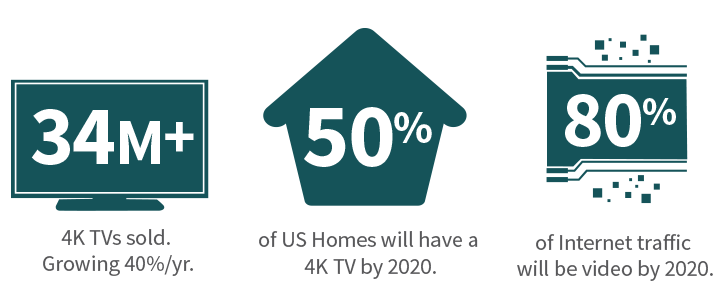“Americans love their TV, and they really love 4K TV.”
- John Smith
USA Today
Data rate and distance dictate whether electrons or photons must be used to move information, whether it’s voice, data or video from point A to point B.
In the mid-20th century, telephony exploded driving new requirements for data rates and distance. The bandwidth required by telephone networks outstripped the ability of copper wiring. Long-distance fiber optic solutions replaced copper wiring and enabled the telecom industry to continue to thrive.
With the rise of the internet, data networks exploded. Once the 10Gbps bandwidth threshold was reached, data centers began replacing their copper wiring with optical interconnects. Modern data centers have moved from 10Gbps to 400Gbps all built on an optical infrastructure.
- John Smith
USA Today
In the video world, standard definition video had negligible bandwidth requirements and high definition video required ~3Gbps bandwidth. This data rate could be handled by copper cables and 1Gbps copper-based IP networks up to hundreds of feet. HDBaseT was born and other Video over IP solutions were developed that brought new features to high def video.
4K video changed everything. At first, much like 480p in the high def era, the industry just focused on the higher resolution which minimized the increase in data rate. But there is so much more to the 4K video experience than just resolution. There are higher frame rates to eliminate motion artifacts, expanded color depth for realism, high dynamic range which enhances contrast to incredible levels.
Televisions, phones, data centers—all around us the world is racing to keep up with consumer demand for rich, lifelike video experiences.

When all the features for “real” 4K are included the data is 18Gbps. Physics limits the ability of copper cables (even the thickest, best cables) to around 20 feet. IP-based solutions can’t compress 18Gbps down to 1Gbps to fit into copper network cables without throwing away video data and creating other trade-offs such as latency. Customers now must carefully parse manufacturer specifications to know whether or not they are getting 18Gbps uncompressed or if they are getting something less.
The bandwidth of 8K is 48Gbps. The copper cables can carry this signal about 6 feet maximum. Video over IP using a 1Gbps network is impossible without tremendous sacrifice. Many video over IP solutions are now recommending a shift from copper to 10Gbps optical networks. For 8K video, these still require almost a 5:1 compression ratio and all the attendant trade-offs.
The pace of modern technology introduction is accelerating with each generation coming faster and faster. Beyond 8K video is 16K video with nearly 100Gbps bandwidth requirements and then there are immersive technologies like 360 video and VR.
The video industry has reached a pivot point where optical technology is required if we value the improved customer experiences that are driving our progress.